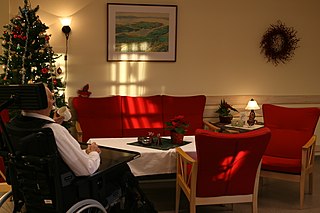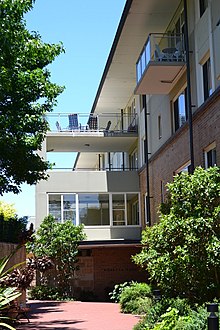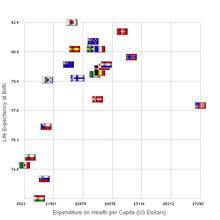A nursing home is a facility for the residential care of older people, senior citizens, or disabled people. Nursing homes may also be referred to as care homes, skilled nursing facilities (SNF) or long-term care facilities. Often, these terms have slightly different meanings to indicate whether the institutions are public or private, and whether they provide mostly assisted living, or nursing care and emergency medical care. Nursing homes are used by people who do not need to be in a hospital, but cannot be cared for at home. The nursing home facility nurses have the responsibilities of caring for the patients' medical needs and also the responsibility of being in charge of other employees, depending on their ranks. Most nursing homes have nursing aides and skilled nurses on hand 24 hours a day.

Elderly care, or simply eldercare, serves the needs of old adults. It encompasses assisted living, adult daycare, long-term care, nursing homes, hospice care, and home care.

Long-term care (LTC) is a variety of services which help meet both the medical and non-medical needs of people with a chronic illness or disability who cannot care for themselves for long periods. Long-term care is focused on individualized and coordinated services that promote independence, maximize patients' quality of life, and meet patients' needs over a period of time.
District Nurses work manage care within the community and lead teams of community nurses and support workers. The role requires registered nurses to take a NMC approved specialist practitioner course. Duties generally include visiting house-bound patients and providing advice and care such as palliative care, wound management, catheter and continence care and medication support. Their work involves both follow-up care for recently discharged hospital inpatients and longer-term care for chronically ill patients who may be referred by many other services, as well as working collaboratively with general practitioners in preventing unnecessary or avoidable hospital admissions.
Gerontechnology, also called gerotechnology, is an inter- and multidisciplinary academic and professional field combining gerontology and technology. Sustainability of an aging society depends upon our effectiveness in creating technological environments, including assistive technology and inclusive design, for innovative and independent living and social participation of older adults in any state of health, comfort and safety. In short, gerontechnology concerns matching technological environments to health, housing, mobility, communication, leisure and work of older people. Gerontechnology is most frequently identified as a subset of HealthTech and is more commonly referred to as AgeTech in Europe and the United States. Research outcomes form the basis for designers, builders, engineers, manufacturers, and those in the health professions, to provide an optimum living environment for the widest range of ages.
A group home, congregate living facility, care home, adult family home, etc., is a structured and supervised residence model that provides assisted living and medical care for those with complex health needs. Traditionally, the model has been used for children or young people who cannot live with their families or afford their own homes, people with chronic disabilities who may be adults or seniors, or people with dementia and related aged illnesses. Typically, there are no more than six residents, and there is at least one trained caregiver there 24 hours a day. In some early "model programs", a house manager, night manager, weekend activity coordinator, and four part-time skill teachers were reported. Originally, the term group home referred to homes of 8 to 16 individuals, which was a state-mandated size during deinstitutionalization. Residential nursing facilities, also included in this article, may be as large as 100 individuals in 2015, which is no longer the case in fields such as intellectual and developmental disabilities. Depending on the severity of the condition requiring one to need to live in a group home, some clients are able to attend day programs and most clients are able to live normal lifestyles.
Ageing, Disability and Home Care NSW (ADHC) was a division of the Department of Family and Community Services in the Government of New South Wales that is responsible for the provision of services to older people, people with a disability, and their families and carers in the state of New South Wales, Australia.

Bolton Clarke is an Australian-based provider of independent living services through at-home care, retirement living and residential aged care. It had its beginnings with the establishment of the Melbourne District Nursing Society in 1885, which later became known as the Royal District Nursing Service (RDNS). RDNS merged with RSL Care in 2015, and in 2017 the organisation adopted its current name to honour two pioneers of Australian healthcare, William Kinsey Bolton and Janet Clarke.
Carers' rights are rights of unpaid carers or caregivers to public recognition and assistance in preventing and alleviating problems arising from caring for relatives or friends with disabilities. The carers' rights movement draws attention to issues of low income, social exclusion, damage to mental and physical health identified by research into unpaid caregiving. In social policy and campaigning the movement distinguishes such people's situation from that of paid careworkers, who in most developed countries have the benefit of legal employment protection and rights at work. With an increasingly ageing population in all developed societies, the role of carer has been increasingly recognized as an important one, both functionally and economically. Many organizations which provide support for persons with disabilities have developed various forms of support for carers/caregivers as well.
In England, social care is defined as the provision of social work, personal care, protection or social support services to children or adults in need or at risk, or adults with needs arising from illness, disability, old age or poverty. The main legal definitions flow from the National Health Service and Community Care Act 1990, with other provisions covering disability and responsibilities to informal carers. That provision may have one or more of the following aims: to protect people who use care services from abuse or neglect, to prevent deterioration of or promote physical or mental health, to promote independence and social inclusion, to improve opportunities and life chances, to strengthen families and to protect human rights in relation to people's social needs.
The Fall Prevention Center of Excellence (FPCE) is a source of fall prevention information for older adults, families, caregivers, professionals, service providers, researchers, and policymakers. FPCE's aim is to provide leadership, create new knowledge, improve practices, and develop fall prevention programs.

The National Disability Insurance Scheme (NDIS) is a scheme of the Australian Government that funds costs associated with disability. The scheme was legislated in 2013 and went into full operation in 2020. Its introduction followed the 15 month long 'Make It Real' campaign which involved community forums, visits to MPs, the holding of a National Disability and Carer Congress, 'Disabilitea' gatherings, and rallies involving 20,000 people. The scheme is administered by the National Disability Insurance Agency (NDIA) and overseen by the NDIS Quality and Safeguards Commission. Bill Shorten provides ministerial oversight as Minister for the National Disability Insurance Scheme.
Four million people in Australia (18.5%) reported having a disability in 2009, according to the results of the Survey of Disability, Ageing and Carers. Males and females were similarly affected by disability.
In 2002, nursing homes in the United Kingdom were officially designated as care homes with nursing, and residential homes became known as care homes.
As of 2017, approximately 1.4 million Americans live in a nursing home, two-thirds of whom rely on Medicaid to pay for their care. Residential nursing facilities receive Medicaid federal funding and approvals through a state health department. These facilities may be overseen by various types of state agency.
The English national framework for NHS continuing healthcare came into force on 1 October 2007 as a development in the light of the case of Coughlan which established that where a person's need is primarily for health care then the health service must fund the whole cost of nursing home placement. People who qualify are entitled to care paid for by the NHS, for which they do not have to pay, rather than social care, which is means-tested. Most of those who qualify need nursing home care. It is in the interests of local social services departments to establish entitlement to continuing healthcare as this relieves them of any financial responsibility. This system has existed in one form or another since the creation of the NHS.
Elder rights are the rights of older adults, who in various countries are not recognized as a constitutionally protected class, yet face discrimination across many aspects of society due to their age.

LGBT ageing addresses issues and concerns related to the ageing of lesbian, gay, bisexual and transgender (LGBT) people. Older LGBT people are marginalised by: a) younger LGBT people, because of ageism; and b) by older age social networks because of homophobia, biphobia, transphobia, heteronormativity, heterosexism, prejudice and discrimination towards LGBT people.
Sydney Community Services (SCS) is a not-for-profit community services organisation based in the Lane Cove and Hunters Hill local government areas in Sydney, New South Wales.

Dementia and Alzheimer's disease in Australia is a major health issue. Alzheimer's disease is the most common type of dementia in Australia. Dementia is an ever-increasing challenge as the population ages and life expectancy increases. As a consequence, there is an expected increase in the number of people with dementia, posing countless challenges to carers and the health and aged care systems. In 2018, an estimated 376,000 people had dementia; this number is expected to increase to 550,000 by 2030 and triple to 900,000 by 2050. The dementia death rate is increasing, resulting in the shift from fourth to second leading cause of death from 2006 to 2015. It is expected to become the leading cause of death over the next number of years. In 2011, it was the fourth leading cause of disease burden and third leading cause of disability burden. This is expected to remain the same until at least 2020.






